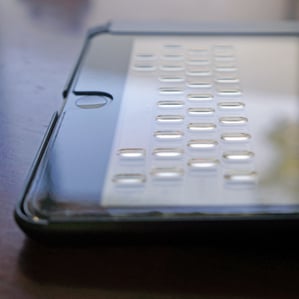Shape-Shifting Touch Screen Buttons Head to Market
As they peck out text on the featureless glass surface of their phone or tablet, some people still mourn the passing of the physical keyboard. Now technology is heading to mass production that can offer the best of both worlds: a featureless surface for watching video and buttons that rise out of it when you need to type.

That technology was developed by startup Tactus Technology, which uses tiny fluid-filled channels and elastic blisters to make buttons rise up from a device’s screen and then disappear without trace when they’re no longer needed (see “Demo: A Shape-Shifting Smartphone Touch Screen”).
Electronics manufacturing giant Wistron has now modified equipment at one of its factories in China to produce touch-screen panels with the shape-shifting technology inside. Wistron is one of the world’s largest electronics manufacturers; it’s made devices for brands including BlackBerry, Apple, and Acer. The company also recently became an investor in Tactus.
The first fruit of the tie-up will go on sale later this year in the form of a protective case with Tactus technology inside for Apple’s iPad Mini. The design includes a transparent screen protector that covers the front of the device. However, sliding a mechanical control on the side of the case raises up a transparent set of buttons or guides on the screen protector, over the touch keyboard, to make typing easier. Sliding the control back will cause those buttons to melt away, leaving a clear, smooth pane of glass.
“Users will still type on the screens as they do today, but with better performance, confidence, and satisfaction,” says Tactus CEO Craig Ciesla.
Tactus won’t reveal the exact design of the case launching this year, or of a similar one slated to launch next year. Nor will it say which brands are behind them. But it did let MIT Technology Review try out an internal prototype case for the iPad Mini with the same basic design.

Sliding the control on the left pushed fluid into a set of guides that rose up between keys on the virtual keyboard. That they were ever there is discernable only by a close examination of the screen protector in the right light. But the panel feels noticeably less smooth to a finger swiping the surface.
The guides provide physical feedback when the fingers don’t directly hit a key, something that’s lacking on a typical touch screen. In a few minutes of testing, it seemed to help my fingers learn how to hit their targets better. Tactus says it has been testing different-shaped guides but won’t say which the first products will use.
The relationship with Wistron could lead morphing buttons to appear in tablets and other devices. Tactus has demonstrated both a prototype seven-inch tablet with its technology fully integrated into its display and an off-the-shelf tablet modified to include the technology. When the buttons are built into a device in that way, their movements are driven by a small electric pump. On the demonstration prototypes, the buttons automatically pop up when the keyboard appears.
“We are only at the beginning of what we expect to be a multiyear partnership, where the Tactus solution will be brought to multiple markets, starting with mobile computing,” says Ciesla. He says the two companies have begun working on the design of products and prototypes for carriers, electronics brands, and retailers. One project is a notebook-style device that has a second, morphing screen where the keyboard would usually be.
Keep Reading
Most Popular
Large language models can do jaw-dropping things. But nobody knows exactly why.
And that's a problem. Figuring it out is one of the biggest scientific puzzles of our time and a crucial step towards controlling more powerful future models.
The problem with plug-in hybrids? Their drivers.
Plug-in hybrids are often sold as a transition to EVs, but new data from Europe shows we’re still underestimating the emissions they produce.
Google DeepMind’s new generative model makes Super Mario–like games from scratch
Genie learns how to control games by watching hours and hours of video. It could help train next-gen robots too.
How scientists traced a mysterious covid case back to six toilets
When wastewater surveillance turns into a hunt for a single infected individual, the ethics get tricky.
Stay connected
Get the latest updates from
MIT Technology Review
Discover special offers, top stories, upcoming events, and more.